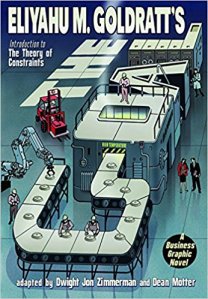
The Goal: A Business Graphic Novel
Eliyahu M. Goldratt
As adapted by Dwight Jon Zimmerman and Dean Motter
The Goal, by Eliyahu M. Goldratt, is one of those books that have changed the world. I personally keep it next to my copy of Deming’s, Out of the Crisis. When one picks up a graphic adaptation of a book that you recently have re-read and you have to answer three questions:
- Is the material true to the original author’s ideas?
- Are the critical concepts easier to consume?
- Do the characters translate from text to pictures well?
The Goal is a business novel used to introduce the Theory of Constraints (ToC). The Theory of Constraints is a framework for improving a process or system by identifying and focusing on the constraints. Because Goldratt wrote The Goal using a novel format, the story and the concepts of the ToC translate well into a graphic novel. That is not to say that Zimmerman’s adaptation was a straight transcription. The language and technology referenced and drawn (Illustrated by Dean Motter – the credits are mute on whether someone inked the book before it was illustrated). The adaptation keeps the basic plot Goldratt laid out and the winnows out some the noise that makes business novels somewhat tedious. Zimmerman delivers all of the highpoints of the ToC and Alex Rogo’s journey of discovery. One of my takeaways from each of my reads of the original book wash of Jonan (professor/consultant) use questions. The graphic novel was no different, as the concept of asking questions rather than telling jumped out to me in the panels on pages 44 -45.
Question one, is the material true to the original author’s ideas? Simply put yes, the core of the material is spot on to the cannon according to Goldratt. One might argue that downplaying of the tension between Alex and his wife is a deviation, however, I felt the marital problems were overplayed in the original.
I have read the original version of The Goal more than a few times. I have a significant bias and am fairly conversant on the ToC, therefore, I was startled to realize that I was picking up nuances that had given me trouble before. The linkage between shipping more product, making more money and real value was honed to a point on the first two panels on page 15, reinforced on page 32 when the management team realizes that focusing on making parts while reducing unit costs increases inventory if not shipped and reduces profit. On page 96 the quote, “running a non-bottleneck machine to its maximum is an act of maximum stupidity” drove the point home that focusing on changing non-bottleneck items in any process is a waste of effort. Panel 3 on page 96 was much more effective than Goldratt’s words to drive the point home. If that was not in your face enough, three panels on page 110 explicitly tell you why spending time improving non-bottleneck items is a mirage.
Question two, are the critical concepts easier to consume? I am biased by my background of having read and re-read the original, but my perception is yes, and after sitting in the front seat of a rental car reading the graphic novel I think I understand the ToC more deeply.
There are a few characters other than the company management team that has stuck in my mind over the years. The primary one is Herbie. This may be due to the conversations I have had with Steve Tendon on the concepts of the ToC or my natural affinity to the slow person in a hiking group. The rendition of Herbie in the sequence pages 48 – 60 did not match my mental image. While not badly drawn I expected Herbie to be less geeky and the group to be more “boy scouty.” A side effect of bringing the text and illustrations into the 21st century. Also, if I had to nitpick, the depiction of Lou, the plant controller’s hair, does not work for me. I am not sure I have ever seen someone with a controller/accounting background with hair like Jon Pertwee’s version of Doctor Who.
Question three: Do the characters translate from text to pictures well? For the most part, the answer is yes.
The graphic novel of The Goal is a great addition to a library that either includes or will soon include the original version of The Goal. The graphic novel is a solid introduction to the ToC and using the ToC. The Goal is an important book if you manage processes or are interested in improving how work is done in the 21st century. The question I now have to answer is which bookshelf to put the graphic novel version of The Goal on, next to my graphic novels or my business books?
Buy a copy of the graphic novel
Buy a copy of the “original”
October 8, 2017 at 12:49 pm
Thanks for the tip. I read the original book several years ago and a ‘graphic re-read’ will be refreshing. I will certainly keep it close to the original – with my other business books.
October 8, 2017 at 2:53 pm
Thank you for mentioning the attribute, refreshing. I think that is something I felt as I read the graphic novel but could not put my finger on!
October 8, 2017 at 4:05 pm
Thank you for this review. The original text version of “The Goal” has now sold 7 million copies in 30 languages so this new format is a welcome initiative. It will be useful to explain the Theory Of Constraints in many circumstances.
For those that interested I did a 3 minute video book review here: https://youtu.be/Bmm7k6k0Dp8
November 8, 2017 at 4:42 pm
[…] https://tcagley.wordpress.com/2017/10/07/a-review-the-goal-a-business-graphic-novel/ […]
November 25, 2017 at 11:56 pm
[…] Re- read our review published on October 17, 2017 […]